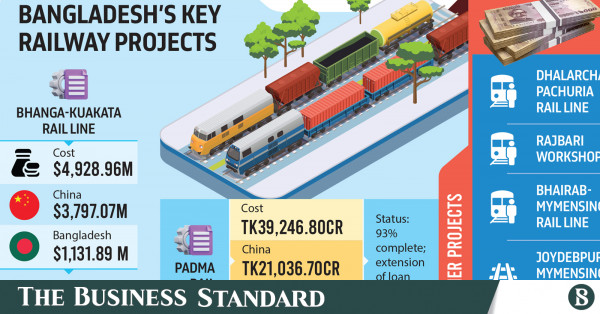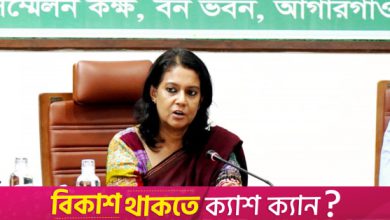Dhaka aims to place rail schemes including Bhanga-Kuakata line


Plans are underway to present these proposals to China
Infographic: TBS
“>
Infographic: TBS
Bangladesh is gearing up to discuss crucial railway projects, including the Bhanga-Kuakata rail line, for possible Chinese financing during Prime Minister Sheikh Hasina’s upcoming visit to China.
The feasibility study for the Bhanga-Kuakata track, completed in June 2022, highlighted the project’s potential to boost regional connectivity. However, the progress has been stalled due to the lack of foreign financing, prompting Bangladesh Railway to explore avenues with Chinese authorities.
According to railway sources, the agendas may include extending the duration of loan availability from China Exim Bank for the Padma rail link, and financing for various other projects.
These projects cover modern workshop construction in Rajbari, the Joydebpur-Mymensingh-Jamalpur rail line, the Bhairab-Mymensingh line and the Dhalarchar-Pachuria rail line.
Railway officials confirmed that draft proposals were sent from the Ministry of Railways to the Ministry of Foreign Affairs for these projects. Plans are underway to present these proposals to China.
Speaking to TBS about the prime minister’s visit to China from 8-11 July, Railway Minister Md Zillul Hakim said discussions will cover several projects, including the Bhanga-Kuakata line. “If we find it beneficial, we will seek funding from China.”
Bhanga-Kuakata rail line to top agenda
The construction of a broad-gauge rail line from Bhanga to Kuakata via Barishal and Payra port is projected to cost $4,928.96 million. Of this amount, Bangladesh plans to secure a $3,797.07 million loan from China, with the remaining $1,131.89 million funded by the government.
Railway Minister Md Zillul Hakim told TBS, “The Bhanga-Kuakata project is a top priority for the prime minister, with China and the ADB eager to finance it. She intends to discuss this initiative during her upcoming visit to China.
“Meanwhile, the Chinese ambassador and various Chinese companies have visited Payra, underscoring China’s keen interest and potential for full project financing. The feasibility study has been completed, and our goal is to implement it swiftly.”
According to ministry sources, the project involves building a 369.40 km single-line railway from Bhanga to Kuakata, scheduled for implementation between July 2022 and June 2029.
The initiative to link Dhaka to the Payra seaport via rail commenced in July 2016.
In October 2018, responding to the prime minister’s direction, a consulting firm was tasked with conducting a feasibility study, chalking out a detailed design, and preparing tender documents for the Bhanga-Kuakata track.
Despite the feasibility study concluding in June 2022, lack of foreign funding has delayed the project’s commencement.
Efforts have been made to secure funding from various countries and organisations. Railway officials, however, remain hopeful that a solution can be found during the prime minister’s upcoming visit to China.
Sources also said 5,638 acres of land will need to be acquired for constructing the railway line, which will connect Faridpur, Gopalgonj, Madaripur, Barishal, Jhalokathi, Barguna, and Patuakhali.
The total route length of the railway will be 214.91km, comprising a main line of 190.11km and a branch line of 24.80km. The embankment along the railway will span 168.88km, accommodating 19 stations.
Extending credit duration for Padma rail link
The Padma rail link project, funded by China Exim Bank, involves an estimated cost of Tk39,246.80 crore. Of this amount, Tk21,036.70 crore is provided as a loan by China Exim Bank, with the remainder expected from government sources.
The loan agreement with China Exim Bank expired on 17 May, but the government has not yet fully accessed the entire loan.
By May, the project achieved 93% physical completion and 81% financial progress. As a result, railway authorities have requested an extension of the deadline until November to secure the remaining loan. This issue is likely to be discussed during the upcoming prime minister’s visit.
SM Salimullah Bahar, chief planning officer of Bangladesh Railway, told TBS that discussions with China Exim Bank have been underway to extend the loan availability period for the Padma rail link project. While there is a verbal agreement to extend the period, formal written confirmation is still pending.
Other projects on the table
Several other projects are likely to be discussed during the prime minister’s visit to China. One of them is the construction of a 15km broad-gauge rail line from Dhalarchar to Pachuria in Rajbari, estimated at Tk1,800 crore and requiring 185 acres of land.
Another potential project for discussion is the establishment of a new Carriage and Wagon Maintenance Workshop in Rajbari, scheduled for implementation from 2025 to 2029.
The feasibility study and design for this project are currently underway. It is expected to cost Tk9,023.60 crore, with Tk7,865.40 crore sought from foreign financing and Tk1,158.20 crore from the government.
The Bhairab-Mymensingh rail project aims to convert a 119.58km metre gauge line to a dual gauge.
The project is estimated to cost $1,804 million, with $1,384.45 million funded by foreign sources and $419.75 million by the government. Currently, the feasibility study and design for this project are ongoing.
Additionally, the Joydebpur-Mymensingh-Jamalpur railway project involves constructing a 144.7 km main line. Discussions on financing for this project may also take place during the prime minister’s visit to China.
Communication infrastructure expert and Bangladesh University of Engineering and Technology (Buet) Prof Hadiuzzaman told TBS that Bangladesh Railway has a 30-year master plan that urgently needs implementation.
He said, “It’s beneficial that the government is seeking foreign financing or initiating projects because our investment capacity is limited. Several railway projects are stalled due to lack of foreign loans.”
Prof Hadiuzzaman also stressed the importance of setting specific investment targets for project execution, advocating for keeping infrastructure development costs reasonable and aligned with neighbouring countries.




